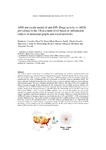Mostrar o rexistro simple do ítem
ANN multiscale model of anti-HIV Drugs activity vs AIDS prevalence in the US at county level based on information indices of molecular graphs and social networks
| dc.contributor.author | González-Díaz, Humberto | |
| dc.contributor.author | Herrera-Ibatá, Diana María | |
| dc.contributor.author | Duardo-Sánchez, Aliuska | |
| dc.contributor.author | Munteanu, Cristian-Robert | |
| dc.contributor.author | Orbegozo-Medina, Ricardo Alfredo | |
| dc.contributor.author | Pazos, A. | |
| dc.date.accessioned | 2016-11-16T13:19:36Z | |
| dc.date.available | 2016-11-16T13:19:36Z | |
| dc.date.issued | 2014 | |
| dc.identifier.citation | González-Díaz H, Herrera-Ibatá DM, Duardo-Sánchez A, Munteanu CR, Orbegozo-Medina RA, Pazos A. ANN multiscale model of anti-HIV Drugs activity vs AIDS prevalence in the US at county level based on information indices of molecular graphs and social networks. J Chem Inf Model. 2014;54(3):744-55 | es_ES |
| dc.identifier.issn | 1549-9596 | |
| dc.identifier.issn | 1549-960X | |
| dc.identifier.uri | http://hdl.handle.net/2183/17567 | |
| dc.description.abstract | [Abstract] This work is aimed at describing the workflow for a methodology that combines chemoinformatics and pharmacoepidemiology methods and at reporting the first predictive model developed with this methodology. The new model is able to predict complex networks of AIDS prevalence in the US counties, taking into consideration the social determinants and activity/structure of anti-HIV drugs in preclinical assays. We trained different Artificial Neural Networks (ANNs) using as input information indices of social networks and molecular graphs. We used a Shannon information index based on the Gini coefficient to quantify the effect of income inequality in the social network. We obtained the data on AIDS prevalence and the Gini coefficient from the AIDSVu database of Emory University. We also used the Balaban information indices to quantify changes in the chemical structure of anti-HIV drugs. We obtained the data on anti-HIV drug activity and structure (SMILE codes) from the ChEMBL database. Last, we used Box-Jenkins moving average operators to quantify information about the deviations of drugs with respect to data subsets of reference (targets, organisms, experimental parameters, protocols). The best model found was a Linear Neural Network (LNN) with values of Accuracy, Specificity, and Sensitivity above 0.76 and AUROC > 0.80 in training and external validation series. This model generates a complex network of AIDS prevalence in the US at county level with respect to the preclinical activity of anti-HIV drugs in preclinical assays. To train/validate the model and predict the complex network we needed to analyze 43,249 data points including values of AIDS prevalence in 2,310 counties in the US vs ChEMBL results for 21,582 unique drugs, 9 viral or human protein targets, 4,856 protocols, and 10 possible experimental measures. | es_ES |
| dc.description.sponsorship | Ministerio de Educación, Cultura y Deportes; AGL2011-30563-C03-01 | es_ES |
| dc.language.iso | eng | es_ES |
| dc.publisher | American Chemical Society | es_ES |
| dc.relation.uri | http://dx.doi.org/10.1021/ci400716y | es_ES |
| dc.rights | This document is the unedited author's version of a submitted work that was subsequently accepted for publication after peer review. To access the final edited and published work, see ACS Publications web page. | es_ES |
| dc.title | ANN multiscale model of anti-HIV Drugs activity vs AIDS prevalence in the US at county level based on information indices of molecular graphs and social networks | es_ES |
| dc.type | info:eu-repo/semantics/article | es_ES |
| dc.rights.access | info:eu-repo/semantics/openAccess | es_ES |
| UDC.journalTitle | Journal of Chemical Information and Modeling | es_ES |
| UDC.volume | 54 | es_ES |
| UDC.issue | 3 | es_ES |
| UDC.startPage | 744 | es_ES |
| UDC.endPage | 755 | es_ES |
Ficheiros no ítem
Este ítem aparece na(s) seguinte(s) colección(s)
-
GI-RNASA - Artigos [193]
-
INIBIC-RNASA-IMEDIR - Artigos [46]






